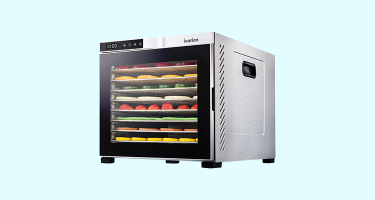No Products in the Cart
- 866-849-3049
- Mon. - Thurs: 9:00 AM TO 6:00 PM, Fri: 9:00 AM TO 1:00 PM
- United States (USD $)
- Canada (CAD $)

Food drying or food dehydration is the process of reducing moisture in food. Food dehydration is one of the oldest methods of preserving food. This method is an alternative to other food preserving techniques like canning and freezing. With that said, it is important to remember dehydrating does not improve the quality of food. Therefore, when choosing produce to dry, make sure the food is high in quality and at the appropriate ripeness. However, do not let this process stress you out; food drying is simple, safe, and easy to learn. And with modern-day food dehydration technology, food can be dried and ready to eat in your home all year-round.

There are many types of dehydration: sun drying, air drying, oven drying, and so on. However, a more modern way to dry your food is electric dehydrating. Of course, to do this you need a food dehydrator. Food dehydrators are compact powerhouses used to dry your food quickly and effectively. They are designed to dry food at 140 °F (60 °C). Most electric dehydrators come with a temperature gauge and adjustment dials to help speed up or slow down drying time. Food dehydrators are equipped with a fan and vents to circulate air making food drying so much easier.
Pretreatment helps to maintain the color, flavor, and texture of different foods. When getting ready to dehydrate, different food requires different preparations. Methods of pretreatment include sulfuring, sulfite dipping, and blanching.

Sulfuring is an old process for pretreating. This process is primarily used for prepping fruits. Fruit is placed in an enclosed box.
Then, sublimed sulfur is ignited and burned within the box. Sulfuring fruits is a process that is best done outside where air is circulated effectively.
Sulfuring will help to prevent fruits from darkening.

Sulfite dipping is used to prevent fruits and vegetables from oxidizing. This process, unlike sulfuring, can be done indoors as well as outdoors. Sulfite dipping will also stop fruits from darkening and is much quicker than sulfuring. Sodium bisulfite or sodium sulfite can be used for this method. For this process, dissolve ¾ – 1½ teaspoons of sodium bisulfite (or if using sodium sulfite, use 1½ – 3 teaspoons) per quart of water. Place sliced fruits in the mixture and soak slices for five (5) minutes. Afterward, remove the slices, rinse off lightly with cold water and place them on food drying trays.

Blanching is a pretreatment done by boiling or steaming food. Blanching can be done on fruits, vegetables, or meats. This process helps to preserve nutrients and prevent flavor loss. To blanch by boiling water, fill a saucepot halfway with water. Bring water to a boil then place and stir food into the boiling water. Cover the saucepot and let sit for three (3) minutes. Then, remove the food and place it into ice cold water to cool. Then, dry food with a towel before dehydrating. To blanch by steaming, fill a saucepot with two (2) inches of water. Then, cover the saucepot until it boils. Remove the cover then place a steamer or wire basket over the boiling water. Place food into steamer, cover tightly with a lid, and let food steam for two to five (2 – 5) minutes until food is heated in the center.